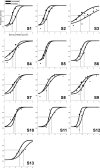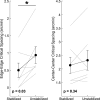Oculomotor Contributions to Foveal Crowding
- PMID: 39455258
- PMCID: PMC11604144
- DOI: 10.1523/JNEUROSCI.0594-24.2024
Oculomotor Contributions to Foveal Crowding
Abstract
Crowding, the phenomenon of impaired visual discrimination due to nearby objects, has been extensively studied and linked to cortical mechanisms. Traditionally, crowding has been studied extrafoveally; its underlying mechanisms in the central fovea, where acuity is highest, remain debated. While low-level oculomotor factors are not thought to play a role in crowding, this study shows that they are key factors in defining foveal crowding. Here, we investigate the influence of fixational behavior on foveal crowding and provide a comprehensive assessment of the magnitude and extent of this phenomenon (N = 13 human participants, four males). Leveraging on a unique blend of tools for high-precision eyetracking and retinal stabilization, we show that removing the retinal motion introduced by oculomotor behavior with retinal stabilization, diminishes the negative effects of crowding. Ultimately, these results indicate that ocular drift contributes to foveal crowding resulting in the same pooling region being stimulated both by the target and nearby objects over the course of time, not just in space. The temporal aspect of this phenomenon is peculiar to crowding at this scale and indicates that the mechanisms contributing to foveal and extrafoveal crowding differ.
Keywords: foveola; ocular drift; temporal crowding.
Copyright © 2024 the authors.
Conflict of interest statement
The authors declare no competing financial interests.
Figures







References
-
- Andersen EE, Weymouth FW (1923) Visual perception and the retinal mosaic. Am J Physiol 64:561–594. 10.1152/ajplegacy.1923.64.3.561 - DOI
MeSH terms
Grants and funding
LinkOut - more resources
Full Text Sources
